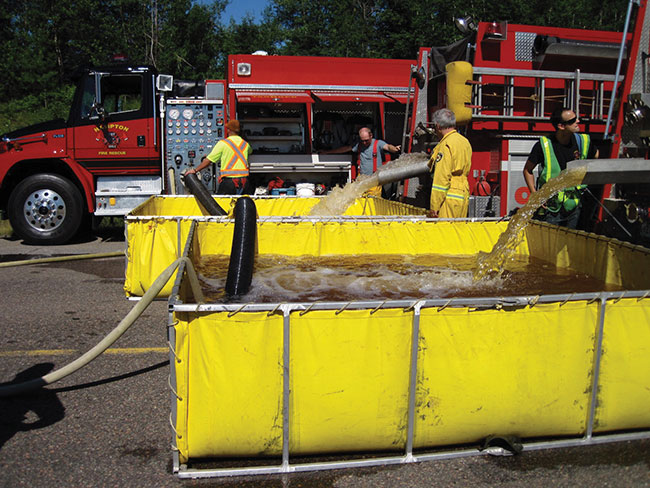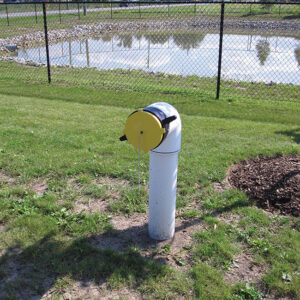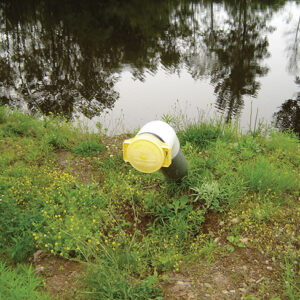
Features
Dry hydrants and rural water supplies
A coordinated solution to a unique challenge for the fire service.
February 17, 2022
By Cyril Hare
 A training exercise in Hampton, N.B.
A training exercise in Hampton, N.B. Fires in rural and suburban areas that are not served by watermains and fire hydrants present unique challenges for the fire service. Firefighters responding to a rural fire must bring their own water or have static sources available at or near the scene, that they can access for fire fighting. Without an adequate water supply, the responding firefighters will not be able to protect exposures and extinguish the fire. There are a number of measures that a fire department can take to ensure that they have enough water to safely control and extinguish a fire.
Standardized equipment and standard operating procedures (SOPs) must be developed by the fire department. Showing up without a plan is a plan for failure. In many rural areas, the fire service must rely on mutual aid to muster enough resources to deal with a fire emergency. All of the fire departments who respond to an emergency, must follow the same SOPs.
An excellent example of mutual aid co-operation is the Royal Valley Firefighters Association. This mutual aid group provides emergency response for a number of municipalities located east of Saint John, N.B. Their tanker shuttle response program, developed by the Kennebecasis Valley Fire Department, has been accredited by Fire Underwriters Survey (FUS) for an industrial/commercial water supply. The participating fire departments have standardized tanker response procedures and practice together regularly. All of their residents and property owners benefit from their combined efforts. One department could not muster sufficient personnel and equipment, however with their combined efforts, these departments are able to provide an exceptional tanker shuttle program.
Pre-planning is key to success in emergency response. You should know your water delivery capabilities and the location of your water sources for your response district and should have pre-plans for the set-up of tanker shuttles and pump operations. NFPA 1142 “Water Supplies for Suburban and Rural Firefighting” and the IFSTA “Pumping Apparatus Driver/Operator Handbook” provide excellent guidance on the use of static water supply sources and the establishment of water shuttle operations.
Each building has a different water supply requirement depending on the building size, construction and occupancy risk. There are a number of methods of calculating the required water supply. The provincial building codes are based upon the National Building Code (NBC). The NBC requires “an adequate water supply for firefighting” for large buildings. The NBC does not provide specific requirements for determining an adequate water supply. Appendix ‘A’ of the NBC provides the following guidance note: “A-3.2.5.7.(1) Water Supply. The intent of Sentence 3.2.5.7.(1) is that an adequate water supply for firefighting be readily available and of sufficient volume and pressure to enable emergency response personnel to control fire growth so as to enable the safe evacuation of occupants and the conduct of search and rescue operations, prevent the fire from spreading to adjacent buildings, and provide a limited measure of property protection.”
The water supply requirements for buildings containing internal fire suppression systems, including sprinkler systems and standpipe systems, are contained in specific standards referenced in the Code. Compliance with the referenced standard, including any variations made by this Code, is deemed to satisfy the intent of Sentence 3.2.5.7.(1). However, it will be necessary to verify that an adequate source of water is available at the building site to meet the required quantities and pressures.
For a building with no internal fire suppression system, the determination of the minimum requirements applicable to the water supply for firefighting is relevant mainly to building sites not serviced by municipal water supply systems. For building sites serviced by municipal water supply systems, where the water supply duration is not a concern, water supply flow rates at minimum pressures is the main focus of this provision. However, where municipal water supply capacities are limited, it may be necessary for buildings to have supplemental water supplies on site or readily available.
The sources of water supply for fire fighting purposes may be natural or developed. Natural sources may include ponds, lakes, rivers, streams, bays, creeks, and springs. Developed sources may include above ground tanks, elevated gravity tanks, cisterns, swimming pools, wells, reservoirs, aqueducts, artesian wells, tankers, hydrants served by a public or private water system, and canals. Consideration should be given to ensuring that water sources will be accessible to fire department equipment under all climatic conditions.
The volume of on-site water supply is dependent on the building size, construction, occupancy, exposure and environmental impact potential, and should be sufficient to allow at least 30 minutes of fire department hose stream use.
Appendix ‘A’ of the Ontario Building Code (OBC) provides guidelines for calculating a required water supply. The OBC also sets out minimum flows that must be achieved based upon the size and fire risk of the building. The OBC guidance, insurer’s standards such as FUS “Water Supply for Public Fire Protection” or NFPA 1142 can be used to calculate the capacity of a reservoir for a firefighting water supply. The NBC requires that a fire hydrant be within 45m of a fire department connection or where no fire department connection is required, within 90 metres of the principle entrance.
Where there are no water mains and pressurized fire hydrants, dry hydrants can be installed to satisfy the building code requirements. The installation of dry hydrants on tanks, ponds, streams and other static sources of water will facilitate a faster establishment of a water supply and safer operations for the emergency responders.
The building codes do not have specific requirements for small buildings such as houses. However, insurers will recognize a dry hydrant as a water supply for firefighting where the dry hydrant is within 300 metres of a residential building and where there is a year-round adequate water supply.
Pumpers should be equipped with sufficient hose to reach from the dry hydrant to the protected structures. In locations where the dry hydrant or other water source is greater than the hose load on the pumper, a pumper relay should be pre-planned. It is far more efficient, reliable and safer to pump rather than to tank water. A two or three truck relay will provide more water to the scene than a tanker shuttle. Tanker shuttles should only be used when the water source is so far away that pumping is not possible.
During my consulting work across Canada, I have seen numerous variations of dry hydrants, many of which were non-functioning or inadequate for the risk being protected. In Canada there is no standard for the design and installation of dry hydrants. Guidance can be found in NFPA 1142. Specifications can also be provided by a number of equipment suppliers who sell dry hydrants. Since each province is responsible for establishing fire service standards for their communities, it would be appropriate for the provincial fire marshals to set a single standard for dry hydrants.
Most jurisdictions use 150 mm piping for the dry hydrant suction pipe however, I have seen piping as small as 65 mm used for dry hydrants. Small suction piping will not provide sufficient water to supply more than a single hose stream. Small suction pipes are not very effective when you need large volumes of water for master stream or aerial operations. Where the suction pipe is unusually long the pipe size may have to be increased to 200 mm or larger.
The suction connection should be equipped with a 150 mm male connection for the pumper to connect to. Each pumper should carry a double female adapter that matches the suction hose to the 150 mm male fitting. It is not recommended to use a female swivel on a dry hydrant. Not all fire apparatus utilize 150 mm suction hose. If a 150 mm female swivel is used the fire department preplan will have to designate which pumpers can be used for drafting. I have reviewed incidents where the pumper that was assigned to draft did not have 150 mm hard suction hose and could not connect to a dry hydrant resulting in a delay in establishing a water supply. In addition, a female swivel requires more maintenance. Dry hydrants are not protected from the weather. The swivel must be lubricated and the gasket inspected for cracking or hardening on a regular basis.
Some jurisdictions require 100 mm Storz connections for the dry hydrant. I have witnessed incidents where the gasket on the Storz hose would not seal and a draft could not be achieved. Also, a 100 mm hose will severely restrict the water available to the pump. NFPA 1142 requires that a dry hydrant be capable of flowing 3800 lpm. NFPA 1901 “Standard for Automotive Fire Apparatus” requires a minimum suction hose size of 150 mm for pumps with a capacity of 4000 lpm or greater. A 100 mm suction is rated for pumps of 1300 lpm or less. There are insurer’s standards that dictate the required flows for various types of buildings and risks. FUS “Water Supply for Public Fire Protection” can be used for guidance in determining minimum water flow requirements. In Ontario the OBC sets out minimum flow requirements of 1800 lpm up to 9000 lpm depending on the size of the building and the risk. Where the flow requirements exceed 4000 lpm it may be necessary to have piping larger than 150 mm and to have more than one dry hydrant.
The dry hydrant should be within three metres of a hard surface that the pumper can be parked on. Initial draft lift should be a maximum of three metres whenever possible. Pumpers are rated based upon a 3 m lift and a greater lift will reduce the efficiency of the pump and the quantity of water available for fire fighting.
The fitting for the dry hydrant should not be higher than the centre of the pump suction. Where the fitting is higher than the pump an air bubble can form in the suction hose and cause the pump to lose suction. If you use clear suction hose, the pump operator can see any air bubble and work it through the pump without losing suction.
Many jurisdictions do not regularly test dry hydrants. The National Fire Code of Canada (NFC) references NFPA 25 “Standard for the Inspection, Testing, and Maintenance of Water-Based Fire Protection Systems” as the standard for maintaining fire protection systems. Section 7.2.2.6. of NFPA 25 sets out the requirements for inspection, testing and maintenance of dry hydrants. There are service companies who will provide regular inspection, testing and flushing of dry hydrants. A dry hydrant is of no use to you if it does not work. Dry hydrants that have been neglected and not flushed have been found full of debris and silt that has rendered them unusable.
Dry hydrants are a valuable tool for responses in areas without watermains and pressurized hydrants. Proper design, installation and regular maintenance will ensure that you have a reliable water supply when you need it.
Cyril Hare is the retired fire chief for the city of Mississauga. Since his retirement, he has been providing fire and life safety consulting services to government and industry across Canada in fire protection and prevention, special risk protection, emergency response, civil litigation and fire and building codes. He is the president of Cyril Hare & Associates Inc., a fire and life safety consulting firm.
Print this page
Advertisement
- Volunteer Vision: Defining the volunteer firefighter
- House fire in Plate Cove West, N.L., claims man’s life

